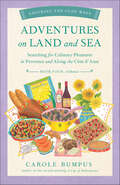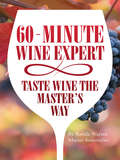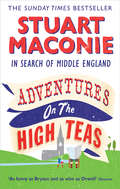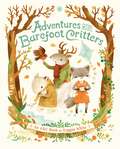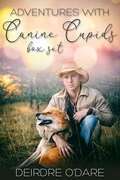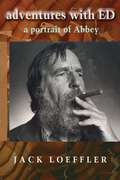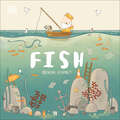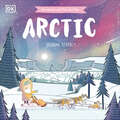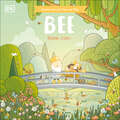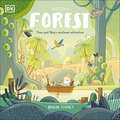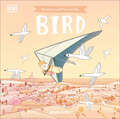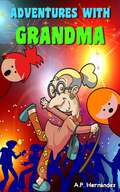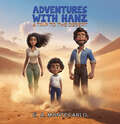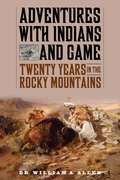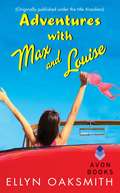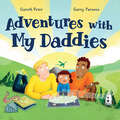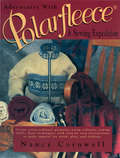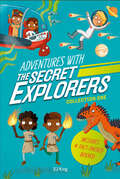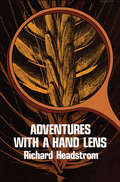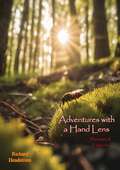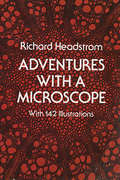- Table View
- List View
Adventures on Land and Sea: Searching for Culinary Pleasures in Provence and Along the Côte d'Azur (Savoring the Olde Ways Series)
by Carole BumpusFans of Peter Mayle and Janine Marsh will enjoy this exploration of medieval villages, cultures, and recipes of France’s Provence. This travelogue is Book 4 in the author’s best-selling series, which has won the IPPY gold medal for Best Culinary Travel Series.Join Carole Bumpus, her husband, Winston, and their friends in Book Four of Savoring the Olde Ways, her culinary-travel series. Following in the footsteps of writer Peter Mayle, Bumpus is on a quest to find the real Provençe. On three separate excursions—from Nice to Nîmes, Moustiers to Marseilles, and San Tropez to San Remy—and while sailing along the Côte d’Azur, she invites you to join her in uncovering the mysteries of Provençe. Are they hidden within their myths, festivals, or traditions? Is it possible they’re veiled in the sheer beauty of the land and sea? Could they be concealed in Roman arenas in Arles, Orange, or Glanum? Or, perhaps, within the ancient methods of traditional cooking or winemaking? Maybe they are hidden in plain sight among the locals who open their hearts, their bistros, and homes to strangers. Yes, you may find it in chefs while cooking in ancient kitchens, in the smile of the shy barmaid who speaks no English, in the giggle of the Pizza Wagon baby, in the agreeable village baker, or in the patient waiter and harbor master—but you will most especially experience it through friends who fling open their doors to share their families’ recipes. Traveling alongside Bumpus, that is where you’ll discover the real Provençe.
Adventures on a Summer’s Day: With Bandit & Company (Bandit And Company Ser. #Vol. 1)
by Pat Becker Margaret GaedderAdventures on a Summer’s Day is the first in a series about a variety of pets known as Bandit and Company. Readers will find the adventures of this troupe both entertaining and heartwarming. "WITH HER USUAL IMAGINATIVE FLAIR, Pat Becker brings to life this new series about a band of pet dogs and cats and their adventures in a loving home in an ideal setting. Readers of all ages will smile within when they recognize the human qualities the author has imbued in all these animals. And the interaction of these pets as they experience their various adventures will undoubtedly connect with discerning readers. The stunning color illustrations by artist Margaret Gaeddert add greatly to the character development and narrative. This is another winning collaboration between the author and the illustrator, both Oklahomans with a love of animals that reflects in their words and art. Readers can look forward to more entertaining and heartwarming stories about these animal characters, as this is the first of an illustrated series about the lives and adventures of the band of dogs and cats known as... Bandit and Company." Darl DeVault, Executive Editor Distinctly Oklahoma Magazine
Adventures on the Ancient Silk Road
by Priscilla Galloway Dawn HunterA gripping account of three dramatic journeys that changed history. The fabled Silk Road conjures up the sights, smells and sounds of faraway lands. But traveling the Silk Road took years, and those who set out encountered bandits, starvation and treacherous storms. Adventures on the Ancient Silk Road introduces readers to three great historical figures: Chinese Buddhist Xuanzang, whose 16-year journey from China to India and back (629-645 AD) is the only source we have for huge chunks of the history and geography of this time. His successful search for Buddhist scriptures changed the course of two great nations. Genghis Khan, bred from infancy to be a warrior, brought the Mongol clans together. He established the greatest empire the world had seen, which ruled the Silk Road from 1201 to 1227. Italian merchant Marco Polo journeyed through China from 1271 to 1295. He changed the way Europe saw the world, and his book even inspired Columbus to sail west across the Atlantic Ocean in search of China. Sidebars and an afterword that updates the story of the Silk Road are featured.
Adventures on the High Teas: In Search of Middle England
by Stuart MaconieEveryone talks about 'Middle England'. Sometimes they mean something bad, like a lynch mob of Daily Mail readers, and sometimes they mean something good, like a pint of ale in a sleepy Cotswold village in summer twilight. But just where and what is Middle England? Stuart Maconie didn't know either, so he packed his Thermos and sandwiches and set off to find out...Is Middle England about tradition and decency or closed minds and bigotry? Is it maypoles and evensong, or flooded market towns and binge drinkers in the park? And is Slough really as bad as Ricky Gervais and John Betjeman make out? From Shakespeare to JK Rowling, Vaughan Williams to Craig David, William Morris to B&Q, Stuart Maconie leads the expedition, with plenty of stop-offs for tea and scones, to discover the truth.
Adventures with Ari: A Puppy, a Leash & Our Year Outdoors
by Kathryn MilesMerle's Door was a sensation because Ted Kerasote writes so beautifully about his dog and his dog's love of the land. In Adventures wtih Ari, Kathryn Miles takes a step back from the wild places Kerasote describes. When she adopts Ari, an exotic Jindo dog, the two of them begin to explore the outdoors together. A dog sees the world quite differently from a person. For starters, he or she is much closer to the ground-to what we've been trying to preserve more and more of these days. A dog is the original environmental activist: The sights, sounds, and smells of nature are what make a dog a dog. And if you want to learn more about nature, try enjoying life like a dog. Kathryn Miles sets out to do just that when she becomes determined to let Ari live life on her own terms. Once some basic ground rules are set, Kathryn takes the leash off her dog and the blinders off her own eyes. A new world soon emerges: She and Ari explore a backyard landscape of grass, mud, snow, trees, and the occasional fox. They find the scent of a northern wind, the footprints of a startled raccoon, and other secrets of the natural world. The puppy's free-spirited outlook teaches Kathryn to see more when she might otherwise have seen less, while adding a certain excitement and clarity of vision. Soon, Kathryn begins to give up control and know the world as Ari learns it. Peppered with factual information about our natural world and the creatures that inhabit it, Adventures with Ari makes compelling reading for dog lovers as well as anyone who's been out and about in the woods. Like most projects of discovery, this process forces Kathryn to uncover much more than the physical-it allows important insight to her thoughts and feelings and her relationship with her entire family, all thanks to a puppy named Ari.
Adventures with Barefoot Critters
by Teagan WhiteFans of the adorable characters in The Quiet Book will love this seasonal romp through the alphabet. Will have definite trade and gift appeal due to Teagan White's sweet anthropomorphic critters. Join an adorable cast of animal characters as they explore the alphabet through the seasons. From gathering honey in spring to building cozy campfires in fall, the friends make the most of each season, both enjoying the great outdoors and staying snug inside. Learning the alphabet is fun when adventuring with these critters, and children and adults alike will delight in Teagan White's sweet, nostalgic illustrations.
Adventures with Buster: The Adventures Begin with a Guide Dog Named Buster
by London Lake Pickett"Adventures with Buster" is a children's book that will entertain and educate readers about guide dogs and blindness. This is the first book in which London Lake Pickett shares experiences she has had with her guide dog named Buster.
Adventures with Canine Cupids Box Set
by Deirdre O'DareCaught up in the demands of their own life and work, many strong, independent men do not have time for love. Their lifestyle leads to being loners and at times they hardly realize something critical is missing from their world. This is when a devoted canine sees a need to bring about crossing their paths with the perfect partner and contriving a chance for them to stumble into the best possible relationship. Cupid could not ask for a more clever helper than a loving dog -- or sometimes two.Contains the stories:Doggone Love: Rancher Damon Carhart expects to spend the rest of his life alone. Then an injury to a beloved stock dog sends him to the nearest veterinary clinic for help. Once he entrusts his canine friend to veterinarian Eric Vann’s care, everything begins to change. And once desire gets a bite on him, what can he do but go along for the wild ride?The Maltese Terror: Landscape architect Nick and rancher Caleb are an unlikely pair. So are their dogs, a Maltese and a Blue Heeler, but the dogs soon form a bond. They seem to be conspiring to get their masters together. Can a couple of canine cupids make it happen?A New Leash on Life: Frenemies, once almost lovers ... Not happily back in their old home town, Justin and Barry have to agree how to handle that old attraction since it refuses to die. Business and pleasure threaten to tangle into a hangman’s knot. Can they somehow find a new leash on life?Love is Snowblind: Aspiring sled dog racer Dylan trusts his beloved lead dogs completely. Following an accident in dangerous circumstances, they accept cheechako Grey into their pack. Can he then refuse the newcomer admission into his life?
Adventures with Ed: A Portrait of Abbey
by Jack LoefflerNo writer has had a greater influence on the American West than Edward Abbey (1927-89), author of twenty-one books of fiction and nonfiction. This long-awaited biographical memoir by one of Abbey's closest friends is a tribute to the gadfly anarchist who popularized environmental activism in his novel The Monkey Wrench Gang and articulated the spirit of the arid West in Desert Solitaire and scores of other essays and articles. In the course of a twenty-year friendship Ed Abbey and Jack Loeffler shared hundreds of campfires, hiked thousands of miles, and talked endlessly about the meaning of life. To read Loeffler's account of his best pal's life and work is to join in their friendship.Born and raised in Pennsylvania, Abbey came west to attend the University of New Mexico on the G.I. Bill. His natural inclination toward anarchism led him to study philosophy, but after earning an M.A. he rejected academic life and worked off and on for years as a backcountry ranger and fire lookout around the Southwest. His 1956 novel The Brave Cowboy launched his literary career, and by the 1970s he was recognized as an important, uniquely American voice. Abbey used his talents to protest against the mining and development of the American West. By the time of his death he had become an idol to environmentalists, writers, and free spirits all over the West.Ed Abbey and Jack Loeffler were like Don Quijote and Sancho Panza. Loeffler delivers his friend, warts and all on a platter full of reverence and irreverence and carefully researched factual information, interspersed with hearty laughter and much serious consideration of all life's Great Questions. Jack's story elucidates and demythifies the Abbey legend, giving us powerful flesh and blood instead.--John Nichols
Adventures with Finn and Skip: A tale about ridding the ocean of plastic pollution (Adventures with Finn and Skip )
by DK Brendan KearneyThrough this charming story, children will become aware of the growing problem of trash polluting the ocean. Fish highlights the issues with a simple and engaging illustrated narrative and also suggests a solution in the form of recycling.All Finn wants is to catch a nice, tasty fish for his dinner, but no matter how hard he tries all he seems to catch at the end of his fishing line is other people's trash. The longer he spends out on the ocean, the more crazy objects he collects! Finn and his dog Skip go home each day with a full boat, but empty tummies.It isn't long before Finn finds a way to reuse and recycle everything he has collected. Pretty soon he makes enough money to make a tasty dinner every day, and under his care, the ocean becomes clean, bright, and full of fish again!
Adventures with Finn and Skip: Arctic (Adventures with Finn and Skip )
by Brendan KearneyFrom award-winning author Brendan Kearney comes the fifth action-packed adventure for Finn and his dog, Skip, that teaches them all about the Arctic and what they can do to protect it.A trip to the Arctic sounds like a winter wonderland dream for Finn and Skip! As they journey to their icy destination through melting ice caps and past hungry polar bears, they soon realize that things are not as they had imagined. Things go from bad to worse when they find themselves floating away on an iceberg! Can they find their way back and uncover what's happening? Offering a gentle, but richly imagined introduction to the environmental concerns facing the Arctic, grown-ups and children will enjoy following the story of Finn and Skip, with its ups and downs, and together, pointing out all the different ways they can help look after one of our planet's most precious environments. With its fun, quirky illustrations and uplifting message about conservation, Adventures with Finn and Skip: Arctic will empower young readers and will leave them with the thought that there is hope after all.
Adventures with Finn and Skip: Bee (Adventures with Finn and Skip )
by Brendan KearneyAn exciting tale about tackling climate change to help protect the animals.Grown-ups and children can enjoy this gentle and imaginative story together, all about the environmental concerns facing our wildlife. Follow the tale of Finn and Skip as they head out for a peaceful picnic - when all of a sudden they hear the sound of buzzing bees, fear sets in and chaos ensues! Can a chance encounter with a beekeeper help them learn the truth about these fuzzy little insects?Introduce 3-5 year-olds to the importance of protecting the environment with this illustrated storybook about climate change and its effects on animals. The ups and downs of this story shows us all the different ways we can help our bees and the environment, through Finn and Skip&’s adventure. This heart-warming climate change story…- Is a positive and hopeful guide that offers children strong practical tips for how they can take care of bees and the planet.- Is perfect for adults and children to share together, as it prompts a wider conversation about the environment.- Offers a charming, humorous, and emotionally gripping message, whilst raising awareness of the environmental issues impacting bees.With its playful, quirky illustrations, Bee will empower young readers with passion and drive. This inspiring and fun story will help children realize that there is hope to protect our valuable wildlife after all.More in the seriesAt DK, we believe in the power of discovery.So why stop there? If you like Adventures with Finn and Skip: Bee, then you&’ll love other titles in the series that raise awareness of important environmental issues. Why not try Adventures with Finn and Skip: Bird, Adventures with Finn and Skip: Fish and Adventures with Finn and Skip: Forest?
Adventures with Finn and Skip: Bilingual Edition English-spanish (Adventures with Finn and Skip )
by Brendan KearneyIntroduce children to the importance of protecting the environment with this illustrated story book about deforestation and its effect on animals. Join fisherman Finn and his dog, Skip, on their second adventurein this illustrated story book for young children, which teaches them about deforestation and what they can do to help. Finn and Skip are on an adventure vacation, cycling through the towering rainforests of central America, when they notice that large patches of trees seem to have disappeared. The plot thickens when an unexpected guest arrives at their campsite—a lonely baby tapir. They feed their new friend, but the next morning they wake up to even more hungry animals. It seems something is afoot in the forest, and Finn and Skip set out to discover what&’s going on...This book is the ideal introduction to the environmental concerns facing our forests, featuring colorful illustrations and an engaging, light-hearted storyline, drawn and written by Brendan Kearney. Grown-ups and children will enjoy reading together and following the story of Finn and Skip, with its ups and downs, and pointing out all the different animals that Finn meets in the rainforest. They&’ll also learn about how using ethical products can help save the animals.With its fun, quirky illustrations, Forest is the perfect addition to a child&’s bookshelf. Young readers will love this picture book with a timely and ultimately uplifting message about protecting the world around us.
Adventures with Finn and Skip: Bird (Adventures With Finn And Skip Ser.)
by Brendan KearneyAn exciting tale about tackling climate change to protect the animalsGrown-ups and children can enjoy this gentle and imaginative story together, all about the environmental concerns facing our wildlife. Follow the tale of Finn and Skip as they go on a hang-gliding adventure up in the clouds - when all of a sudden Finn&’s map gets caught around a swan&’s neck! Introduce 3-5 year-olds to the importance of protecting the environment with this illustrated storybook about climate change and its effects on animals. The ups and downs of this story shows us all the different ways we can help our birds and the environment, through Finn and Skip&’s adventure. This heart-warming climate change story:- Features lots of practical tips for taking care of the planet, like cycling instead of taking cars, planting trees, and even growing their own vegetables- Taps into growing eco-awareness trend, and shows the benefits of making sustainable decisions- Is perfect for adults and children to share together, as it prompts a wider conversation about the environment- Is charming, humorous, and emotionally gripping, which helps to make this quite frightening subject matter more approachableWith its playful, quirky illustrations, Bird will empower young readers with passion and drive. This inspiring and fun story will help children realize that there is hope to protect our valuable wildlife after all.More in the SeriesAt DK, we believe in the power of discovery.So why stop there? If you like Bird, complete the collection with our other titles you&’ll love about climate change, Fish and Forest.
Adventures with Grandma: Children’s book (7 - 12 years). Grandma rocks!
by A. P. HernándezAndrea and Jamie, 9 and 7 years old, are siblings, and this summer they’re going to spend a few days with their grandmother because their parents have won a raffle and are going on a trip. Their parents’ instructions are very clear: “Be very good,” “Take good care of Grandma,” and “Grandma is very old, look after her.” However, left alone with their grandmother, Andrea and Jamie are in for a huge surprise. Grandma may not be as boring as they had thought after all ... A fun book with humor, action and adventure for boys and girls! Recommended reading for children aged 7 and up.
Adventures with Hanz - A Trip to the Desert
by E. A. MontecarloJoin Hanz on an unforgettable journey full of excitement, bravery, and heartwarming family moments! In this captivating picture book, Hanz embarks on a surprise trip to the desert with his parents. Little does he know, the adventure ahead will challenge them with thrilling obstacles and unexpected encounters. As dangers arise, Hanz must rely on his courage and teamwork to overcome them. His heroic deeds highlight the power of bravery and compassion. Perfect for children aged 4-8, Adventures with Hanz: A Trip to the Desert is a beautifully illustrated story that teaches valuable lessons about courage, problem-solving, and the importance of family. This delightful tale is sure to become a bedtime favourite, inspiring young readers to embrace their own adventures with open hearts and fearless spirits.
Adventures with Indians and Game: Twenty Years in the Rocky Mountains
by William A. AllenAn adventure tale, historical memoir, and hunting journal in a single, enthralling narrative. At the tender age of seven, little William shot his first chipmunk and was “imbued with the spirit of sportsmanship. ” In the following years of his colorful life, Allen wore many hats, living as a tracker, miner, blacksmith, gunsmith, prospector, freighter, and even dentist. Above all, however, was his passion for adventure, the hunt, and his dealings with Native Americans in the waning light of the late nineteenth century in Dakota Territory. A born observer, Allen describes a world that, by the time he wrote his book in 1903, no longer existed. Allen’s accounts of life in the frontier wilderness—hunting otters and grizzly bears, a secondhand reflection on the tragedy of the Battle of the Little Bighorn, witnessing a battle between a rattlesnake and an eagle, and brutal fights and lifelong friendships with Sioux and Crow Indians—reflect a lost era of romantic heroism, untouched nature, and early Western sentiments, both antiquated and modern, toward Native Americans. Not only the thrilling memoir of one man’s life, Adventures with Indians and Game is also a compendium of Western game—how to track, hunt, and kill for entertainment—in a time when hunting for pleasure, rather than food, in the West was a foreign concept. As a pioneer in the field of hunting as a sport in the West, Allen provides a significant historical account of the spirit that spearheaded it. A teetotaler and man of his word, Allen’s narrative voice is strong, straightforward, and immediate, even though he died in 1944. Adventures with Indians and Game is a true-life adventure tale and hunting journal that promises an enthralling and eye-opening read.
Adventures with Leaders & Enders: Make More Quilts in Less Time!
by Bonnie K. HunterAn easy method to faster quilt-making, and incredible patterns to make use of your scrap stash. What if you could piece quilts even faster, work on more than one quilt simultaneously and save money, fabric and thread all at the same time? Bonnie K. Hunter will show you how to put the concept of Leaders & Enders to work quickly and easily, expanding your creativity, and upping your productivity all at the same time. If you have ever found yourself paralyzed by your stash, overwhelmed by scraps you just can't bear to toss out, arm yourself with a new rotary blade for your cutter, make yourself a cup of tea and start reading. This book is not only full of beautiful scrap quilts that can be made in between the lines of other sewing, but also contains many ideas for getting your ever burgeoning scrap stash under control, into useable sized pieces that work well with one another, and ready to be sewn into quilts you've always wanted to make. Bonnie K. Hunter has done it again!
Adventures with Max and Louise
by Ellyn OaksmithThis novel was originally published as an e-book in 2011 under the title Knockers. If you like Sophie Kinsella, Meg Cabot, and Liza Palmer, you'll love Ellyn Oaksmith! Molly Gallagher does not like to be the center of attention. As the mysterious Diner X, her pseudonym for a restaurant review column, she thrives on blending in. But before you can say "medical malpractice," she wakes up from a routine procedure to find that her chart got switched with someone else's, and now her A cup runneth over. Suddenly, unassuming Molly is turning heads wherever she goes. The man she's been pining for since high school is sitting up and taking notice, a very handsome stranger has captured her attention, and her lifelong dream of publishing a cookbook is about to come true. But Molly feels like an imposter. Will some advice from a very strange place help her figure out how to navigate her new, full-figured world? Molly realizes her revamped shape might change her life. She just doesn't anticipate quite how much . . .
Adventures with My Daddies
by Gareth PeterSet off on a series of incredible adventures with a family that has two dads! As they read bedtime stories with their little one, the pages burst into colorful life. Together, this LGBTQ+ family battles dragons, dodges deadly dinosaurs, zooms to the moon, and explores the world in a hot air balloon, before winding down to sleep in a wonderfully cozy ending. This rhyming read aloud celebrates the power of imagination and champions the love that brings all kinds of families together. Author and illustrator team Gareth Peter and Garry Parsons deliver an imaginative, heartwarming tale filled with bright and optimistic acrylic and pencil illustrations
Adventures with Polarfleece: A Sewing Expedition
by Nancy CornwellJourney into virtually uncharted territory and discover the wonderful uses of fleece! Allow author Nancy Cornweel to lead you on a sewing expedition. Adventures with Polarfleece covers territories as fabric and garment care, sewing machine and serger basics, pattern choices and simple design changes. Included are 200 photographs and 150 color illustrations to guide you on a tour of quick and easy techniques for seams, ready-to-wear edge finishing and no-hassle zippers. Nancy also shows a safety technique on how to avoid the dreaded "frog mouth" buttonhole! Adventures with Polarfleece also includes a special excursion in ultrasuede - drawcords, patches, button loops, piping and pockets; sculpturing, polar pintucks and embroidery. A collection of fifteen projects are included. This sewing expedition has been photographed every step of the way and is clearly mapped and illustrated. Included are instructions for jackets, pull-overs, a cape, a five-minuet hat, blankets, pillows, exceptional accessories and more! Explore and discover the endless project possibilities for the entire family. Fleece is one of the sewing world's premier fabrics for comfort and warmth. It is easy to sew with beautiful results. Nancy Cornwell will lead you down a path of discovery filled with excitement, intrigue and inspiration. If the urge to explore is part of your nature, Adventures with Polarfleece is sure to generate great excitement. The heart of a fallen-away sewer will soon be recaptured and new sewers will be intrigued and inspired.
Adventures with The Secret Explorers: 4-Book Box Set of Educational Fiction Chapter Books Books (The Secret Explorers)
by SJ KingDive into the world of the Secret Explorers and join them on their action-packed adventures in this four-book boxset collection.Meet the Secret Explorers - a band of brainiac kids from all around the world, here to take young readers on a series of fact-filled fictional adventures! Each with their own specialty, from outer space to dinosaurs, these young globetrotters will teach kids that learning can be fun, encouraging them to become experts in something they are passionate about.With thrilling narratives and plenty of humour, children will love the first four books in the fact-filled series are included in this collection: The Secret Explorers and the Lost Whales, The Secret Explorers and the Comet Collision, The Secret Explorers and the Tomb Robbers, and The Secret Explorers and the Jurassic Rescue. Join marine-life expert Connor on an undersea adventure, space brainiac Roshni on a mission to fix a space probe, history nerd Gustavo in a battle against tomb robbers, and dinosaur expert Tamiko as she races to save a dinosaur egg!This epic adventure is packed with:- Four thrilling adventure books for young readers- Fun facts and illustrations about marine life, outer space, ancient Egypt and dinosaurs- Simple and informative diagrams telling kids all they need to know about different subjects- Quizzes, mission notes, and a glossary of words with definitionsEach story fast-paced, fun, and full of facts, The Secret Explorers books by SJ King are perfect for children aged 7-9 who are into all things nature, science, technology, and adventure. This four-book collection is the perfect gift for boys and girls who are naturally curious and care about the planet, is packed with lots of information that provides a magical introduction to STEM subjects. At the end of this adventure series, the "Mission Notes" provides a useful summary of all the scientific facts and discoveries made throughout the story. With fun illustrations, quizzes, and a vocabulary list, the educational value of this book is outstanding and great for a classroom read!
Adventures with a Hand Lens
by Richard HeadstromWith an ordinary magnifying glass and this book as your guide, 50 adventures in close observation await you. These entertaining nature studies take you on field trips in and around your home, calling attention to interesting features of dozens of familiar or overlooked plants, insects, and other animals, and common materials like cloth, quartz, and the paper on which this book is printed.A great deal of basic natural-science theory and detail is presented in this delightful narrative. Flowers and grasses, fish scales, moth and insect wings, egg cases, buds, feathers, seeds, leaf scars, moss, molds, ferns, and common crystals are among the many structures examined, often comparatively. Many natural processes and behavior patterns are observed -- seed dispersal and other methods of reproduction, protective coloration, rusting symbiosis, fertilization of the soil, breathing and case building of insects, and many others, all with only an inexpensive hand lens as equipment and with "specimens" you probably pass by going for a walk. More than 200 labeled illustrations accompany the text.The author is a former teacher and associate curator of the New England Museum of Natural History. No previous science background is assumed of readers, and curious readers of almost any age will find this book an interesting introduction to numerous facets of nature study.
Adventures with a Hand Lens [Illustrated Edition]
by Richard HeadstromIncludes over 200 illustrations by the author.Here are fifty adventures that any of us could have. The only equipment needed is a hand lens and an inquiring mind. At home, in the woods, fields, ponds and along the roadside are familiar things that under the glass show us exciting and sometimes beautiful details that we could not see without this help.Have you ever looked at the antennae of an ant under a lens, or seen the bristles on an earthworm? Did you know that a certain moss has a capsule that looks like a pepper box? A piece of granite seen through a glass shows us that it is made up of various crystals. These are the kinds of things that an adventurer with a hand lens can discover. Not only has the author described these experiments in lively and clear text but he has illustrated them with over two hundred line drawings.
Adventures with a Microscope
by Richard HeadstromWith a simple microscope and this book, you can embark on 59 wonderful adventures in the natural world -- make discoveries about the structures of numerous microscopic animals; find out what everyday objects and foods really look like at the cellular level; gain an understanding of how to prepare specimens and slides; and learn about many scientific phenomena such as how a fly can walk upside down on the ceiling. It's all here in simple-to-understand language and 142 clear line drawings.The author first examines under the microscope such everyday objects as a human hair, air bubble, scale of a herring, poppy seed and sugar crystal, and then offers through-the-microscope views of such creatures and objects as the water flea, hydra, house fly, amoeba, euglena, volvox, diatoms, desmids, algae, blood corpuscles, honey bee, rotifer, water-mites, potato starch, and other food substances, lichen, paramecium, coffee, sponge, chalk, yeast, bacteria, mustard, pepper, bryozoan, moss, mushroom, molds, cotton, and other textile fibers, ferns, dragon-flies, flea, spider, roots, and other plant structures, paper, aphid, fingerprints, nervous system of the grasshopper, and more.Richard Headstrom, formerly associated with the New England Museum of Natural History and an experienced teacher and writer on natural science for young people, has made this book simple enough for any beginner at home as well as interesting for more experienced students and lay readers. Enjoyable and instructive, these adventures with a microscope will appeal to all who are curious about what there is to see beyond the range of the naked eye.
